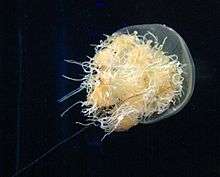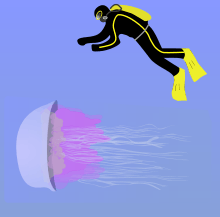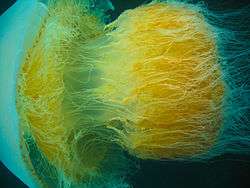Nomura's jellyfish
Nomura's jellyfish (エチゼンクラゲ, echizen kurage, Nemopilema nomurai) is a very large rhizostome jellyfish, in the same size class as the lion's mane jellyfish, the largest cnidarian in the world. It is edible but not considered high quality.[1] It is the only species in the monotypic genus Nemopilema.
| Nomura's jellyfish | |
|---|---|
 | |
| Nemopilema nomurai in the Kaiyūkan-aquarium of Ōsaka | |
 | |
| Size comparison of a Nomura's jellyfish next to a diver | |
| Scientific classification | |
| Kingdom: | Animalia |
| Phylum: | Cnidaria |
| Class: | Scyphozoa |
| Order: | Rhizostomeae |
| Family: | Rhizostomatidae |
| Genus: | Nemopilema |
| Species: | N. nomurai |
| Binomial name | |
| Nemopilema nomurai (Kishinouye, 1922) | |
| Synonyms | |
| |
Overview

The diameter when fully grown is slightly greater than the height of an average man. The species was named in tribute to Mr. Kan'ichi Nomura (C18–C19), Director General of the Fukui Prefectural Fisheries Experimental Station, who in early December 1921 sent a specimen in a 72-litre wooden tank to Professor Kishinouye, who found that it was unknown and spent some time at the station to study living specimens.[2]
Growing up to 2 m (6.6 ft) in diameter and weighing up to 200 kg (440 lb),[3][4] Nomura's jellyfish reside primarily in the waters between China and Japan, primarily centralized in the Yellow Sea and East China Sea.[5] Population blooms appear to be increasing with frequency in the past 20 years.[6] Possible reasons for the population increase in Nomura's Jellyfish include climate change, overfishing, and coastal modification adding substrate for asexually producing polyps.[5]
Jellyfish have two main types of muscle: epitheliomuscular cells and striated muscle cells. Researchers found that gene families that are closely associated with striated muscle were expressed in the bell portion of the jellyfish, providing evidence that striated muscle plays a significant role in jellyfish motility.[7]
In 2009, a 10-tonne (11 ton) fishing trawler, the Diasan Shinsho-maru, capsized off Chiba on Tokyo Bay as its three-man crew tried to haul in a net containing dozens of Nomura's jellyfish; the three were rescued by another trawler.[8][9]
Life cycle
The life cycle of Nemopilema nomurai is very similar to that of other rhizostomes. Nomura’s jellyfish are normally found in the Yellow Sea and populations are generally maintained there year round. During June and July changes in the water salinity lead to the expatriation of larval stage jellyfish via the Tsushima strait. In 2005 the largest blooms were in late October.[5] It is noted that this species of jellyfish in six months can grow from the size of a grain of rice to greater than 6 feet wide.[10]
Ecology
While jellyfish blooms have been documented in the Sea of Japan since the writing of their first history book, the blooms of Nemopilema nomurai have been more recent. Since the beginning of the 20th century the instances of N. nomurai explosive blooms have been on the increase,[5] a fact not helped by their size – being one of the largest species of jellyfish recorded. This species of jellyfish feeds mostly on zooplankton in all stages of life, feeding on larger fish as they grow larger. Their only predators consist of swordfish, tuna, sunfish, leatherback turtles and humans.[10]
Envenomations
Severe envenomations are becoming more common than ever. Victims of a sting from the N. Nomurai jellyfish may present symptoms of itching, swelling, acute pain, local erythrosis, and inflammation; in severe cases, the envenomations can cause death. [11]The nematocyst venom of the N. Nomurai is composed of complex, toxic mixtures of proteins. Further research is in progress to determine the key factors within these protein mixtures, which could predict specific symptoms from the venom and aid in treatment. Using experimental omics-based approaches, research has revealed different sting related proteins and enzymatic components such as metalloproteinase and phospholipase A2s, as well as differences in hemolytic activity.[12] However, research has yet to provide a correlation between these components and symptoms of the envenomation.
Uses
Since the recent increase in blooms, research has been underway to find uses for the Nomura’s jellyfish. Each year this species costs Japanese fisheries serious damage and so an economic solution may be found in converting this invasion into a resource.[5]
As food
The Japanese company Tango Jersey Dairy produces a vanilla and jellyfish ice cream using Nomura's jellyfish.[13][14] Consuming echizen kurage is potentially dangerous if the toxic part is not thoroughly cleaned and cooked.[15]
Medical
One study sought to use the mucin of the Nomura’s jellyfish to treat joint disease such as osteoarthritis.[16]
Agriculture
Like many invasive species, such as the cane toad, a simple solution is to take the species and convert them into fertilizer. Another study aimed at using an aqueous methanol extract of dried medusa to inhibit the growth of weed seedlings when added to soil.[17]
References
- Kawahara, M. & M. N Dawson (2007). "Nemopilema nomurai - a big problem". The Scyphozoan. Retrieved 28 September 2013.
-
Hansson, Hans G. "Biographical Etymology of Marine Organism Names. N & O". Tjärnö Marine Biological Laboratory. Retrieved 16 November 2009.
Drs Toyokawa Masaya & Kensuke Yanagi kindly informed about Kanichi Nomura
- Discovery News -- Monster Jellyfish
- McClain, Craig R.; Balk, Meghan A.; Benfield, Mark C.; Branch, Trevor A.; Chen, Catherine; Cosgrove, James; Dove, Alistair D.M.; Gaskins, Lindsay C.; Helm, Rebecca R. (2015-01-13). "Sizing ocean giants: patterns of intraspecific size variation in marine megafauna". PeerJ. 3: e715. doi:10.7717/peerj.715. ISSN 2167-8359. PMC 4304853. PMID 25649000.
- Uye, S., 2008. Blooms of the giant jellyfish Nemopilema nomurai: a threat to the fisheries sustainability of the East Asian Marginal Seas. Plankton and Benthos Research, 3 (Supplement): 125-131. http://www.plankton.jp/PBR/issue/vol03_suppl/03suppl_125.pdf
- Richardson, A.J., Bakun, A., Hays, G.C., and Gibbons, M.J. 2009. The jellyfish joyride: causes, consequences and management responses to a more gelatinous future. Trends in Ecology & Evolution, 24: 312-322.
- Kim, Hak-Min (2019). "The Genome of the Giant Nomura's Jellyfish Sheds Light on the Early Evolution of Active Predation". BMC Biology. 17 (1): 28. doi:10.1186/s12915-019-0643-7. PMC 6441219. PMID 30925871.
- Foster, Joanna M. (2 February 2012). "Evidence for Jellyfish Invasion Is Lacking, Study Says". The New York Times.
- Ryall, Julian (2 November 2009). "Japanese fishing trawler sunk by giant jellyfish". London: Telegraph.co.uk. Retrieved 3 November 2009.
- Metropolitan Oceanic Institute & Aquarium (2014). "Nomura's Jellyfish (Nemopilema nomurai)". Archived from the original on 25 June 2016. Retrieved 27 May 2016.
- Yue Y, Yu H, Li R, Xing R, Liu S, Li K, Wang X, Chen X, Li P (January 2017). "Functional Elucidation of Nemopilema nomurai and Cyanea nozakii Nematocyst Venoms' Lytic Activity Using Mass Spectrometry and Zymography". Toxins. 9 (2): 47. doi:10.3390/toxins9020047. PMC 5331427. PMID 28134758.
- Yue Y, Yu H, Li R, Liu S, Xing R, Li P (March 2019). "Insights into individual variations in nematocyst venoms from the giant jellyfish Nemopilema nomurai in the Yellow Sea". Scientific Reports. 9 (1): 3361. Bibcode:2019NatSR...9.3361Y. doi:10.1038/s41598-019-40109-4. PMC 6399247. PMID 30833625.
- "Gigantic jellyfish invade the Sea of Japan". Animal News: Animal Planet. April 26, 2010. Archived from the original on July 12, 2015. Retrieved July 11, 2015.
- Simpson, Aislinn (July 21, 2009). "Japan hit by invasion of giant Nomura's jellyfish". The Telegraph. Retrieved July 11, 2015.
- Lee, Samantha (2015-10-09). "The 21 most dangerous foods in the world". Business Insider Singapore. Retrieved 2018-01-18.
- Kiminori Ushida; et al. (2015). "Combined preparation for treating joint diseases". Patent US9095551. Retrieved 27 May 2016.
- Watanabe et al., 2015. Weed Inhibitory Activity of Nomura’s Jellyfish, 165-167. https://www.jstage.jst.go.jp/article/ecb/53/3/53_165/_pdf
External links
| Wikimedia Commons has media related to Nemopilema nomurai. |
- Giant Echizen jellyfish off Japan coast, (BBC News, November 30, 2009)
- Giant Jellyfish Invade Japan (National Geographic)
- Super blobs' deep impact (The Sydney Morning Herald)
- Chefs prepare for annual giant jellyfish invasion (Pink Tentacle)
- Japanese fishermen brace for giant jellyfish (CNN)
- The Age Of Jellyfish (spectre footnotes (blog), July 31, 2009)
- Giant Jellyfish Head North in Warming World, MSNBC